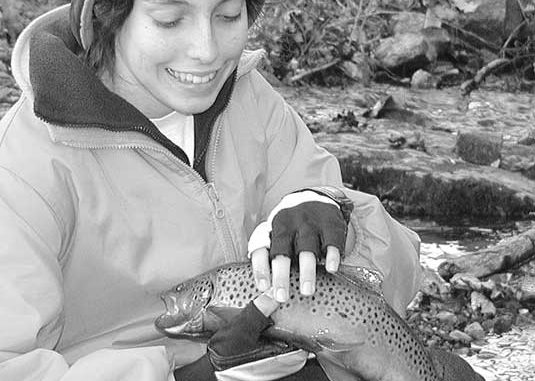
Louisiana is divided into districts, each of which has some real gems waiting for bass fishermen.
It’s the most prolific trout fishery in the lower 48, but unless you’re under age 16 you can’t enjoy a minute of it.This tiny stream is located 20 miles south of Mountain Home, Ark. It’s only a mile long, originating on a bluff above Norfork Lake Dam, and emptying into the Norfork River just a few hundred yards below the dam.
It’s called Dry Run Creek. The irony is that in fly fisher’s terms, a “dry run” is a stretch of water that has few or no fish. Never has there been a more inappropriate name.
The Norfork River is a world-class trout water. It contains abundant rainbows, browns and cutthroats, averaging 14 to 18 inches. But it also holds some that weigh in double-digits, up to world-record size of over 30 pounds!
Most of these trout were born and raised at the federal hatchery adjacent to Dry Run. Their passion is to return to their origin and reproduce. The creek is as far as they can get. Many times, it is stuffed with fish along its entire length, including a few of the goliaths.
Nine hours after departing Baton Rouge, my daughter Cokie and I had arrived at Norfork Dam. There was still enough time to get in a few hours’ fishing. Quickly we rigged up, and tied a size 16 tan sowbug, suspended 2 feet below a tiny float.
The rod of choice was her Orvis Clearwater 6 1/2-foot 4-weight. The canopy along the banks demands a short rod, not only for casting purposes, but in the event the fish spits the hook, the line won’t spring up high into the trees.
Nearly all fishing is done from the bank or from a few decks. As I peered from the first deck we came to, I spotted several nice bows holding in what trout anglers call “green water.” It’s the deeper water immediately behind a large rock.
Cokie’s first two drifts went ignored. On her third cast, as the float moved with the current along the edge of the holding area, it suddenly came to an abrupt stop. She drew back the rod gently, careful not to break the 5X tippet on what might be a trophy. The rainbow jumped several times, providing just the sort of welcome she was hoping for. I climbed to the water’s edge, and without lifting the fish from the water, removed the barbless hook from its mouth.
Single, barbless hooks are a requirement on Dry Run, as is release of all fish caught. Other rules are that a parent or guardian is required to be with a child at all times, and that fishing is allowed only from sunrise to sunset.
Thanks to a cold wind, we didn’t wait until sunset to pack it in. Chilled to the bone, we anxiously awaited a warm dinner and a good night’s rest at the motel. There’s no shortage of good, affordable restaurants and motels in Mountain Home.
The next morning called for a stop at Blue Ribbon Fly Shop, south of town on Highway 62. The shop owner, Dale Fulton, always keeps a good supply of yuk bugs in sizes 6 and 8. Our intent was to go after the big ‘uns.
Spring break and Thanksgiving week coincide with the spawning runs of rainbows and browns, respectively. Nighttime temperatures can go below freezing. On this day, the air, the trout and we were all slow to warm up. Few fish were caught, though many followed the fly.
But around noon, patience paid off. We were near one of the discharges from the hatchery that flow into the creek. Cokie was drifting her yuk bug above a deep rockpile when a giant shadow slipped out of nowhere and sucked in the bug.
If your conception of coldwater trout is limited to what you’ve seen in the kiddie ponds at outdoor shows, or in some of those tourist streams around Gatlinburg, have I got news for you. Trout that have spent more than a year in a tailwater are a totally different animal. They make a redfish look like a wuss.
Cokie had hooked into Mr. Big, a rainbow estimated no less than 15 pounds. It surged to the head of the pool, then doubled back along the far bank time and again. Keeping constant sideways pressure to force it away from rocks and limbs, Cokie managed after 15 minutes to get it within short reach.
I waded a few feet off the bank, attempting to get both arms under the fish. Several bystanders had been watching the epic battle rage from the walkway above, and one young boy came down to shoot the photo.
As Cokie waded into the water, I tried to lift the leviathan. Never mind that I can lift a 75-pound canoe above my head, I was still no match for this guy. With one complete motion of his body, he knocked me back into the water, broke the leader,and swam away.
The big bow was gone before Cokie could pose with him on film. I sat in the water embarassed and heartbroken.
Our third and final day saw many browns, bows and cutthroat trout fall to various flies that Cokie presented to them. There were many leaping fish, some up to 20 inches, but nothing even close to Mr. Big. We did see a couple of his caliber, but none showed any interest in her offerings.
On the way home, I reminded Cokie that all the times her brothers had fished Dry Run, neither of them had ever landed a fish like Mr. Big, and that she had a few years left to fulfill that goal.
She smiled and said, “You and I know I’ve already done it.”
Proving once again that big trout, like all things spiritual, are grounded in faith.

